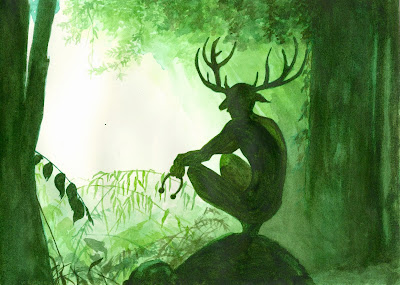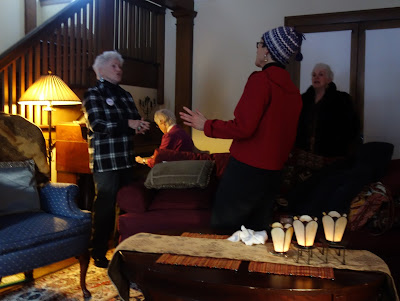Earlier this week I hosted an afternoon tea for a number of my friends at Hare House, my home in south Minneapolis. My good friend and housemate, Tim, co-hosted.
It was an
Australian afternoon tea as, well, I'm Australian . . . and because it was inspired by the afternoon teas I experienced as a child growing up in rural Australia.
I also like to say that my gathering was a way to "reclaim the tea party" from the fascist movement that has emerged in U.S. politics in the past few years, the members of which call themselves the
Tea Party.
Monday's afternoon tea was the third I've hosted in the Twin Cities, For images of the first,
click here. For images of the second,
click here.
Left: Some of the tea cups and saucers from my collection. Each has a story as I always try to acquire a new one when visiting an antique store in every new place I visit.
For instance, the front cup and saucer (second from right) was bought for $6.00 at an antique store in Brainerd, when Brent and I
recently visited Gull Lake.
After I shared these images on Facebook, some of my Australian family and friends teasingly questioned just how authentic an
Australian tea party it was, given that I served no jam and cream scones,
lamingtons, fruit cake, cucumber sandwiches, sponge cake,
jam drops, lemon meringue pie, or
ANZAC biscuits. And it's true, the treats I served – including pie, coffee cake, cookies, and brownies – are all common to the U.S. I guess I'll just have to try better next time.
My friend Andrew, however, came to my defense, noting that my afternoon tea was "a laudable effort in a country where tea drinking is largely unappreciated."
Above: With Tim, his girlfriend Colleen (left) and my friend
Kathleen – Monday, January 18, 2016.
Right: Friends (from left) Barb, Rita, and
Brigid.

Above: Friends (from left) Mary, Rick, Tim, Kathleen, Kate, Florence, and
Lisa.
Above: Colleen, Tim, and Kathleen.
Above: Kate, Mary, Brigid, and Florence.
Above: Brigid, Rick, Tim, Colleen, Kate, and Florence.
Above: Rita, Lisa, and Kathleen.
Above: With friends Brigid and Barb.
Above: Brigid, Kathleen and Rita, leading us in a rendition of "Sentimental Journey." Kate's accompanying them on the piano.
Above: Kate, tinkling the ivories. That's the complete collection of Winston Graham's
Poldark novels (now a
successful TV series) on top of the piano!
__________________________________
I mentioned at the beginning of this post that my afternoon tea was inspired by the morning and afternoon teas I grew up with in Australia.
 Above:
Above: The oldest photo I have of an Aussie afternoon tea! It shows my
Mum (right) in 1981 with family friend Gwen Riordan and Gwen's youngest daughter Diane.
Right: Gwen (center) with her sister Barbara (left) and daughters (from left) Diane, Wendy and Denise – January 2009.
The Riordan family lived on a property at Kelvin, about 18 kilometres northeast of my hometown of
Gunnedah. I have very happy memories of the tennis parties they'd host and the delicious morning and afternoon teas that were always an essential part of these gatherings. I also have happy memories of hiking through the nearby Kelvin Hills with Gwen and members of both my family and the Riordan family. For more images of the Kelvin area, the Riordan family, and our times hiking in the Kelvin Hills, see
here.
Above: I can't believe how thick my eyebrows were back in 1987! Anyway, here I am, pictured second from right, with (from left) Bruce and Lynne Riordan, Peter Newbury, and Dad & Mum. We're at the kitchen table of my childhood home in Gunnedah. It was Easter break from uni and my friend Peter and I must have traveled up from Canberra (where we were both studying that year) to Gunnedah.
Above: Mum, Aunty Phyllis and Nanna Smith partaking in the great Aussie tradition of afternoon tea! – January 1994. This photo was taken just a few days before my
relocation to the U.S. from Australia.
Above: During an
April 2014 visit to Gunnedah, family friends Peter and Delores Worthington put on a wonderful morning tea for my parents and I. Pictured from left:
Dad,
Mum, Delores, and Peter.
Do you recall how I mentioned earlier in this post about my friend Andrew coming to the defense of my tea party? Well, Peter and Delores are his parents. Andrew recently said on Facebook: "I'm a stickler for homogeneity, but used to give my mother different
Royal Doulton/
Albert cup and saucer sets as presents for birthdays, Christmas, etc., and she always said she liked the variety."
Just think, in the photo above we're probably drinking tea from some of Andrew's presents to his mother!
Right: The one Royal Albert cup and saucer I have in my collection. It's actually my latest acquisition. I bought it not last weekend but the weekend before for $6.00 at an antique store in Brainerd, when my friend Brent and I were visiting Gull Lake.
Above: Afternoon tea with Mum and Dad at
Tea and Treasures, "the best Tea House in Port Macquarie" – Friday, March 27, 2015. (For more images of my March 2015 Australian Sojourn,
click here.)
See also the previous Wild Reed posts:
• Christmas 2015: Reflections and Celebrations
• Turning 50





































































